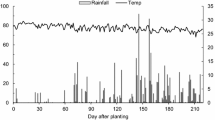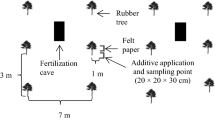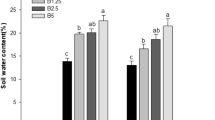Abstract
Lack of good potting media to produce good planting materials for rubber plantations is one of the problems affecting natural rubber (NR) growers and this demands viable solutions. This work describes the effects of potting media made with horse waste-based bokashi compost on the growth and biomass accumulation of rubber seedlings. The research involved four potting media (M1 = 1:0 soil:bokashi, M2 = 1:1 soil:bokashi, M3 = 2:1 soil:bokashi, and M4 = 1:2 soil:bokashi), as well as PB 350 and RRIM 2002 seedlings. Growth parameters assessed were plant height and girth size per plant. Shoot and root dry weights were computed to evaluate the biomass accumulation using indices such as the relative growth rate (RGR), net assimilation rate (NAR), leaf area ratio (LAR), specific leaf area (SLA), root–shoot ratio (RSR) and leaf weight ratio (LWR). Significant growth in terms of plant height was achieved in M4 with the tallest plants (114.1 cm) compared to 93.1 cm in M1 (corresponding to 74.4 and 42.0% height increment, respectively). Plant height increased by 66.3% in RRIM 2002 as compared to 54.6% in PB350. Also, M4 provided a significant shoot dry weight of 139.0 g/plant, leaf area of 4233.2 cm2/plant compared to 58.1 g/plant and 1832.3 cm2/plant, respectively, in the control-M1. Interaction results indicated that RRIM 2002 clone provided the highest RGR (0.011 g/g/day) in M4. This work also demonstrated that adding bokashi to the soil significantly improved most of the chemical properties (but did not significantly change the physical properties) with RRIM 2002 clone responding better to bokashi potting media compared to PB 350 clone.


Similar content being viewed by others
References
Stevanus CT, Bintarti AF, Setiawan N (2016) The effect of oil palm frond-based compost as growing media amendment for rubber (Hevea Brasiliensis, Müll. Arg.) planting material. Malays J Soil Sci 20:195–209
Ardika R, Sanchez PB, Badayos RB, Cruz PCS (2017) Growth of PB 260 clone (Hevea brasiliensis (Willd. ex A. Juss.) Muell-Arg.) in different potting media and fertilization scheme. Agrivita 39:182–191. https://doi.org/10.17503/agrivita.v39i2.956
Tariq U, Ur Rehman S, Khan MA, Younis A, Yaseen M, Ahsan M (2012) Agricultural and municipal waste as potting media components for the growth and flowering of Dahlia hortensis “Figaro.” Turk J Bot 36:378–385
Landis TD, Jacobs DF, Wilkinson KM, Luna T (1990) Growing media. Contain Tee Nurs Man 2:41–85
Hubbel KL, Ross-Davis AL, Pinto JR, Burney OT, Davis AS (2018) Toward sustainable cultivation of Pinus occidentalis Swartz in Haiti: effects of alternative growing media and containers on seedling growth and foliar chemistry. Forests. https://doi.org/10.3390/f9070422
Mulugeta G (2014) Effect of different potting mixture on the seedling growth and survival of Albizia gummifera and Cordia africana. J Nat Sci Res 4:25–33
Tura HASFS, Komicho SKGDN, Gifawesen ST (2016) Evaluation of the effect of different pot sizes and growing media on the seedling growth morphology of Cajanus cajan and Sesbania sesban in dryland areas, Southern parts of Ethiopia. J Biol Agric Healthc 6:62–67
Salisu MA, Sulaiman Z, Samad MYA (2020) Growth and biomass yield of rubber seedlings grown on soilless and soil-based media. Bangladesh J Bot 49:229–236. https://doi.org/10.3329/bjb.v49i2.49296
Sendi H, Mohamed MTM, Anwar MP, Saud HM (2013) Spent mushroom waste as a media replacement for peat moss in Kai-Lan (Brassica oleracea var Alboglabra) production. World J Sci. https://doi.org/10.1155/2013/258562
Eudoxie GD, Alexander IA (2011) Spent mushroom substrate as a transplant media replacement for commercial peat in tomato seedling production. J Agric Sci 3:41–49. https://doi.org/10.5539/jas.v3n4p41
Chrysargyris A, Prasad M, Kavanagh A, Tzortzakis N (2020) Biochar type, ratio, and nutrient levels in growing media affects seedling production and plant performance. Agronomy. https://doi.org/10.3390/agronomy10091421
Gungor F, Yildirim E (2013) Effect of different growing media on quality, growth and yield of pepper (Capsicum annuum L.) under greenhouse conditions. Pak J Bot 45:1605–1608
Jayasinghe GY, Arachchi IDL, Tokashiki Y (2010) Evaluation of containerized substrates developed from cattle manure compost and synthetic aggregates for ornamental plant production as a peat alternative. Resour Conserv Recycl 54:1412–1418. https://doi.org/10.1016/j.resconrec.2010.06.002
Hernández Gómez FO, Osorio Vega NW, Leon Pelaez JD (2018) Biological inoculation and organic amendments as strategies to improve ebony (Caesalpinia ebano) tree-seedling growth at the nursery. Rev Fac Nac Agron Medellin 71:8489–8497. https://doi.org/10.15446/rfna.v71n2.67392
Huang L, Gu M (2019) Effects of biochar on container substrate properties and growth of plants—a review. Horticulturae 5:1–26. https://doi.org/10.3390/horticulturae5010014
Carlile WR, Cattivello C, Zaccheo P (2015) Organic growing media: constituents and properties. Vadose Zone J 14:1–13. https://doi.org/10.2136/vzj2014.09.0125
Miller JH, Jones N (1995) Organic and compost-based growing media for tree seedling nurseries, 264. World Bank Publications, Washington, DC
Shamshuddin J, Daud NW (2011) Classification and management of highly weathered soils in Malaysia for production of plantation crops. Princ Appl Assess Soil Sci. https://doi.org/10.5772/29490
Kaushalya Madhavi BG, Khan F, Bhujel A, Jaihuni M, Kim NE, Moon BE, Kim HT (2021) Influence of different growing media on the growth and development of strawberry plants. Heliyon 7:e07170. https://doi.org/10.1016/j.heliyon.2021.e07170
Maass V, Céspedes C, Cárdenas C (2020) Effect of Bokashi improved with rock phosphate on parsley cultivation under organic greenhouse management. Chil J Agric Res 80:444–451. https://doi.org/10.4067/S0718-58392020000300444
Álvarez-Solís JD, Mendoza-Núñez JA, León-Martínez NS, Castellanos-Albores J, Gutiérrez-Miceli FA (2016) Effect of bokashi and vermicompost leachate on yield and quality of pepper (Capsicum annuum) and onion (Allium cepa) under monoculture and intercropping cultures. Cien Investig Agr 43:243–252. https://doi.org/10.4067/s0718-16202016000200007
Inckel M, de Smet P, Tersmette T, Veldkamp T (2005) The preparation and use of compost. 27 Agromisa
Christel DM (2017) The use of bokashi as a soil fertility amendment in organic spinach cultivation. The University of Vermont and State Agricultural College, Burlington
Abo-Sido N (2018) Analysis of the nutrient composition, efficacy, and sustainability of bokashi fertilizers
Quiroz M, Céspedes C (2019) Bokashi as an amendment and source of nitrogen in sustainable agricultural systems: a review. J Soil Sci Plant Nutr 19:237–248. https://doi.org/10.1007/s42729-019-0009-9
Ginting S (2019) Promoting Bokashi as an organic fertilizer in Indonesia: a mini review. Int J Environ Sci Nat Resour 21:142–144. https://doi.org/10.19080/ijesnr.2019.21.556070
Lasmini SA, Nasir B, Hayati N, Edy N (2018) Improvement of soil quality using bokashi composting and NPK fertilizer to increase shallot yield on dry land. Aust J Crop Sci 12:1743–1749. https://doi.org/10.21475/ajcs.18.12.11.p1435
Bócoli FA, Marcon JA, Izidoro M, de Toledo BP, de Oliveira SER, Spalevic V, de Souza PS (2020) Bokashi use in the passionfruit (Passiflora edulis L.) germination and initial growth. Agric For 66:101–111. https://doi.org/10.17707/AgricultForest.66.4.08
Goulart RGT, dos Santos CA, de Oliveira CM, Costa ESP, de Oliveira FA, de Andrade NF, do Carmo MGF (2018) Desempenho agronômico de cultivares de alface sob adubação orgânica em seropédica—RJ. Rev Bras Agropecuária Sustentável 8:66–72
Faozi K, Yudono P, Indradewa D, Maas A (2018) Banana stem Bokashi and its effect to increase soybean yield (Glycine max L. Merrill) in coastal sands area. Agrotechnology. https://doi.org/10.4172/2168-9881.1000184
Lima CEP, Fontenelle MR, Silva LRB, Soares DC, Moita AW, Zandonadi DB, Souza RB, Lopes CA (2015) Short-term changes in fertility attributes and soil organic matter caused by the addition of em Bokashis in two tropical soils. Int J Agron. https://doi.org/10.1155/2015/754298
Olle M (2021) Review: Bokashi technology as a promising technology for crop production in Europe. J Hortic Sci Biotechnol 96:145–152. https://doi.org/10.1080/14620316.2020.1810140
Wijayanto T, Tufaila M, Sarman AM, Zamrun MF (2016) Influence of bokashi fertilizers on soil chemical properties, soybean (Glycine max (L.) Merrill) yield components and production. WSES Trans Biol Biomed 13:134–141
Yamada K, Xu HL (2001) Properties and applications of an organic fertilizer inoculated with effective microorganisms. J Crop Prod 3:255–268
Pangaribuan DH, Yasir M, Utami NK (2012) Dampak bokashi kotoran ternak dalam pengurangan pemakaian pupuk anorganik pada budidaya tanaman tomat. J Agron Indones (Indones J Agron) 40:204–210
Yong-Hong L, Tai-Yuan C, Chih-Hang C, Tzu-Che L, You-Jen L, Mei-Juan L, Jia-Hong L (2021) Shorten the producing process of horse manure to fermented compost and appropriate fertilization on crops. J Agric Biotechnol Sustain Dev 13:1–11. https://doi.org/10.5897/jabsd2020.0381
Wijayanto T, Zulfikar Tufaila M, Sarman AM, Zamrun MF (2016) Agricultural wastes based-organic fertilizers (Bokashi) improve the growth and yield of soybean (Glycine max (L.) Merrill). Int J Agric Sci 1:27–32
Hata FT, Ventura MU, de Fregonezi GAF, de Lima RF (2021) Bokashi, boiled manure and penergetic applications increased agronomic production variables and may enhance powdery mildew severity of organic tomato plants. Horticulturae 7:1–8. https://doi.org/10.3390/horticulturae7020027
Peters S, Koschinsky S, Schwieger F, Tebbe CC (2000) Succession of microbial communities during hot composting as detected by PCR-single-strand-conformation polymorphism-based genetic profiles of small-subunit rRNA genes. Appl Environ Microbiol 66:930–936. https://doi.org/10.1128/AEM.66.3.930-936.2000
Ashraf AN, Zulkefly S, Adekunle SM, Samad MYA (2017) Growth and biomass yield of oil palm (Elaeis guineensis) seedlings as influenced by different rates of vermicompost. Eur J Eng Res Sci 2:17–21
Cahyo AN, Ardika R, Saputra J, Wijaya T (2014) Acceleration on the growth of rubber planting materials by using foliar application of humic acid. Agrivita 36:112–119. https://doi.org/10.17503/Agrivita-2014-36-2-p112-119
Hoffmann WA, Poorter H (2002) Avoiding bias in calculations of relative growth rate. Ann Bot 90:37–42. https://doi.org/10.1093/aob/mcf140
Pandey R, Paul V, Das M, Meena M, Meena RC (2017) Plant growth analysis: manual of ICAR sponsored training programme for technical staff of ICAR Institute on physiological techniques to analyze the impact of climate change on crop plants. ICAR-Indian Agricultural Research Institute (IARI)
Seman IF, Sulaiman Z, Adekunle SM, Samad MYA (2018) Effect of different media combination on growth and biomass production of oil palm (Elaeis. guineensis) seedlings. Int J Environ Agric Biotechnol 3:140–146. https://doi.org/10.22161/ijeab/3.1.18
Chapman HD (1965) Cation‐exchange capacity. Methods of soil analysis: part 2 chemical and microbiological properties, vol 9, pp 891–901
Hendershot WH, Lalande H, Duquette M (1993) Ion exchange and exchangeable cations. Soil Sampl Methods Anal 19:167–176
Walkley A, Black IA (1934) An examination of the Degtjareff method for determining soil organic matter and a proposed modification of the chromic acid titration method. Soil Sci 37:29–38
Nelson DA, Sommers L (1983) Total carbon, organic carbon and organic matter. Methods Soil Anal Part 2 Chem Microbiol Prop 9:539–579
Walkeley A (1947) A critical examination of a rapid method for determination of organic carbon in soils: effect of variation in digestion conditions and of inorganic soil constituents. Soil Sci 63:251–257
Bray RH, Kurtz LT (1945) Determination of total, organic, and available forms of phosphorus in soils. Soil Sci 59:39–46
Sung CTB, Talib J (2006) Soil and plant analyses Vol. I soil physics analyses
Romano N, Santini A (2002) Water retention and storage. In: Dane JH, Topp GC (eds) Methods of soil analysis part 4. Physical methods. Soil Science Society of America, Madison, pp 727–736
Demirsoy M, Sezgin UZUN (2019) The quantitative effects of different growing media on the growth of aubergine (Solanum melongena L.) and cucumber (Cucumis sativus L.) in autumn. Int J Environ Trends IJENT 3:151–158
Sayara T, Basheer-Salimia R, Hawamde F, Sánchez A (2020) Recycling of organic wastes through composting: process performance and compost application in agriculture. Agronomy. https://doi.org/10.3390/agronomy10111838
Shamshuddin J, Darus A (1979) Mineralogy and genesis of soils in Universiti Pertanian Malaysia, Serdang, Selangor. Pertanika 2:141–148
Abad M, Noguera P, Burés S (2001) National inventory of organic wastes for use as growing media for ornamental potted plant production: case study in Spain. Bioresour Technol 77:197–200. https://doi.org/10.1016/S0960-8524(00)00152-8
Noguera P, Abad M, Puchades R, Maquieira A, Noguera V (2003) Influence of particle size on physical and chemical properties of coconut coir dust as container medium. Commun Soil Sci Plant Anal 34:593–605. https://doi.org/10.1081/CSS-120017842
Sánchez-Monedero MA, Roig A, Cegarra J, Bernal MP, Noguera P, Abad M, Antón A (2004) Composts as media constituents for vegetable transplant production. Compost Sci Util 12:161–168. https://doi.org/10.1080/1065657X.2004.10702175
Zaha C, Dumitrescu L, Manciulea I (2013) Correlations between composting conditions and characteristics of compost as biofertilizer. Bull Transilv Univ Braşov Eng Sci Ser. I(6):51
Saharinen MH (1998) Evaluation of changes in CEC during composting. Compost Sci Util 6:29–37. https://doi.org/10.1080/1065657X.1998.10701938
Hazelton P, Murphy B (2016) Interpreting soil test results: what do all the numbers mean? CSIRO Publishing, Clayton
Ghanem K, El-Zabalawy K, Mustafa A, Elbanna B (2017) Impact of using compost Bokashi resulting from recycling kitchen waste on head Lettuce (Lactuca sativa var. capitata L.) grown organically at home. J Soil Sci Agric Eng 8:21–27. https://doi.org/10.21608/jssae.2017.37071
Picariello E, Pucci L, Carotenuto M, Libralato G, Lofrano G, Baldantoni D (2021) Compost and sewage sludge for the improvement of soil chemical and biological quality of Mediterranean agroecosystems. Sustain 13:1–15. https://doi.org/10.3390/su13010026
Shipley B (2006) Net assimilation rate, specific leaf area and leaf mass ratio: which is most closely correlated with relative growth rate? A meta-analysis. Funct Ecol 20:565–574. https://doi.org/10.1111/j.1365-2435.2006.01135.x
Sopheaveasna M, Phearun P, Gohet E, Lacote R, Snoeck D, Lim Khan Tiva LK (2019) Fertilizer application on immature rubber. The case of clone PB 330 in Tboung Khmum Province, Cambodia. IRRDB
Pandit NR, Schmidt HP, Mulder J, Hale SE, Husson O, Cornelissen G (2020) Nutrient effect of various composting methods with and without biochar on soil fertility and maize growth. Arch Agron Soil Sci 66:250–265. https://doi.org/10.1080/03650340.2019.1610168
Mislan R, Sulaiman Z, Noordin WD, Abdullah SNA, Ismail MR, Selamat A, Samad MYA, Puteh AB, Salisu MA (2020) Growth and physiological response of selected clones of rubber grown under different water frequencies. Bangladesh J Bot 49:205–213. https://doi.org/10.3329/bjb.v49i2.49293
Salisu MA, Noordin WD, Sulaiman Z, Halim RA (2017) Influence of soilless potting media on growth and vegetative traits of immature rubber (Hevea brasiliensis müll. Arg.). Bangladesh J Bot 46:451–457
Riaz A, Arshad M, Younis A, Raza A, Hameed M (2008) Effects of different growing media on growth and flowering of Zinnia elegans cv. Blue point. Pak J Bot 40:1579–1585
Gómez-Velasco DA, Álvarez-Solís JD, Ruiz-Valdiviezo VM, Abud-Archila M, Montes-Molina JA, Dendooven L, Gutiérrez-Miceli FA (2014) Enzymatic activities in soil cultivated with coffee (Coffea arabica L. cv ‘Bourbon’) and amended with organic material. Commun Soil Sci Plant Anal 45(19):2529–2538
Li X, Schmid B, Wang F, Paine CET (2016) Net assimilation rate determines the growth rates of 14 species of subtropical forest trees. PLoS One 11:1–13. https://doi.org/10.1371/journal.pone.0150644
Chapin FS, van Cleve K (2000) Approaches to studying nutrient uptake, use and loss in plants. Springer, Dordretch, pp 185–207
Chatzistathis T, Therios I (2013) How soil nutrient availability influences plant biomass and how biomass stimulation alleviates heavy metal toxicity in soils: the cases of nutrient use efficient genotypes and phytoremediators, respectively. Biomass Now Cultiv Util Matovic DM. https://doi.org/10.5772/53594
Hunt R, Causton DR, Shipley B, Askew AP (2002) A modern tool for classical plant growth analysis. Ann Bot 90:485–488. https://doi.org/10.1093/aob/mcf214
Xiaohou S, Min T, Ping J, Weiling C (2008) Effect of EM Bokashi application on control of secondary soil salinization. Water Sci Eng 1:99–106. https://doi.org/10.3882/j.issn.1674-2370.2008.04.011
Acknowledgements
The authors wish to thank the Ministry for Higher Education Malaysia and Universiti Putra Malaysia for supporting this research.
Funding
This research was funded by Ministry of higher education and UPM Grant number 5540304.
Author information
Authors and Affiliations
Corresponding author
Ethics declarations
Conflict of interest
On behalf of all authors, the corresponding author declares that there is no conflict of interest.
Additional information
Publisher's Note
Springer Nature remains neutral with regard to jurisdictional claims in published maps and institutional affiliations.
Rights and permissions
About this article
Cite this article
Gashua, A.G., Sulaiman, Z., Yusoff, M.M. et al. Potting media made with bokashi compost to improve the growth and biomass accumulation of rubber seedlings. J Rubber Res 25, 127–139 (2022). https://doi.org/10.1007/s42464-022-00163-6
Received:
Accepted:
Published:
Issue Date:
DOI: https://doi.org/10.1007/s42464-022-00163-6




